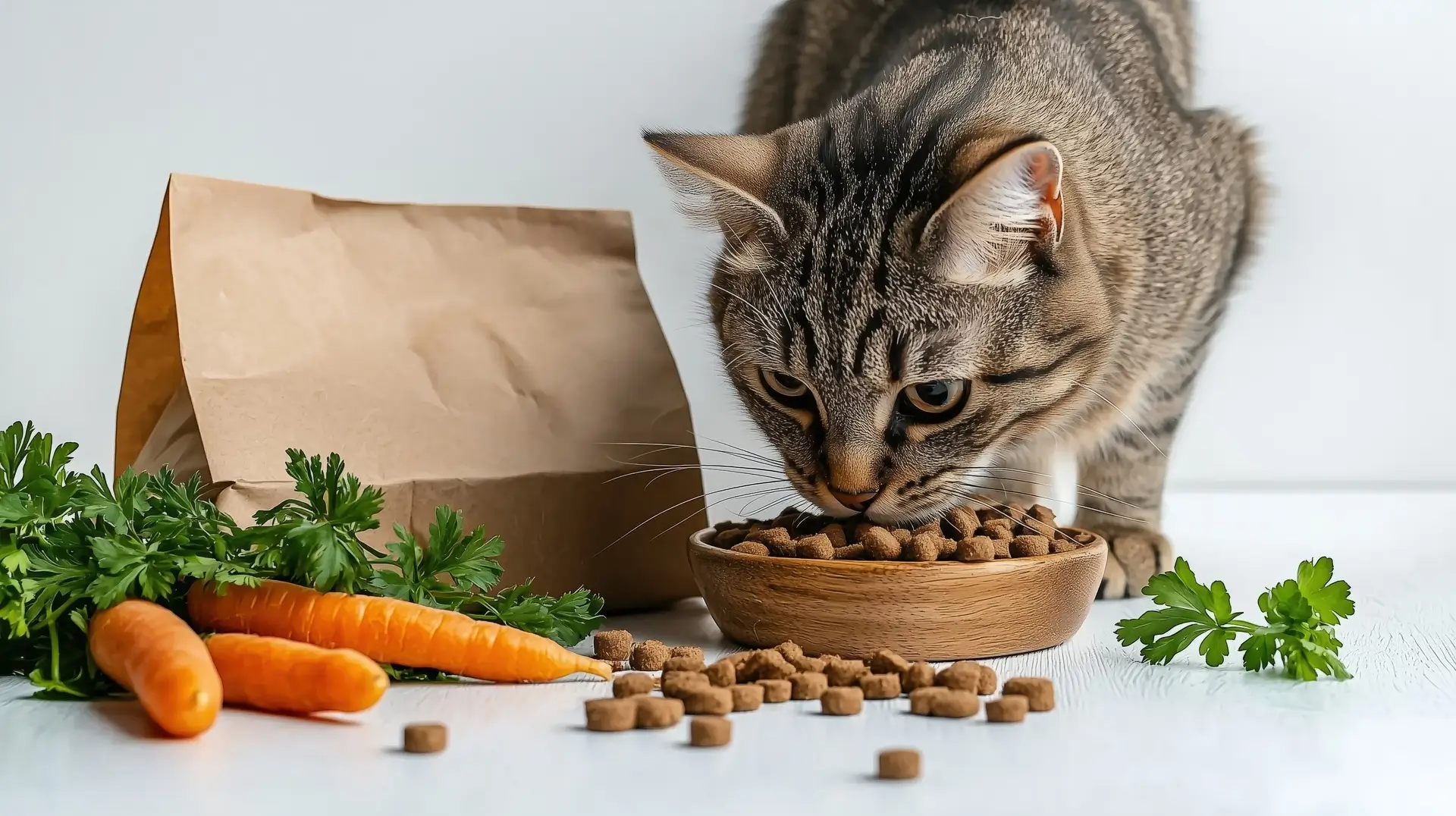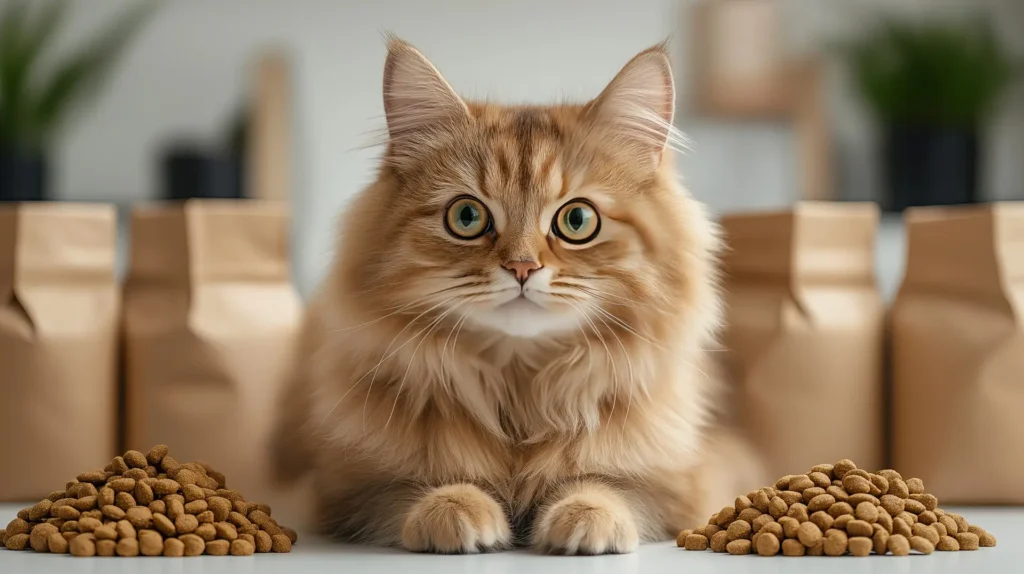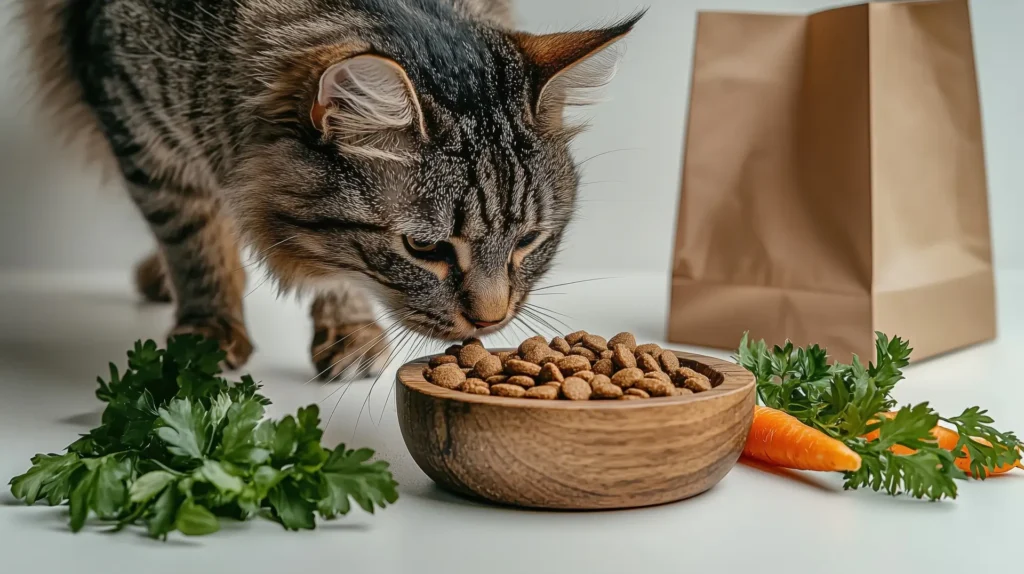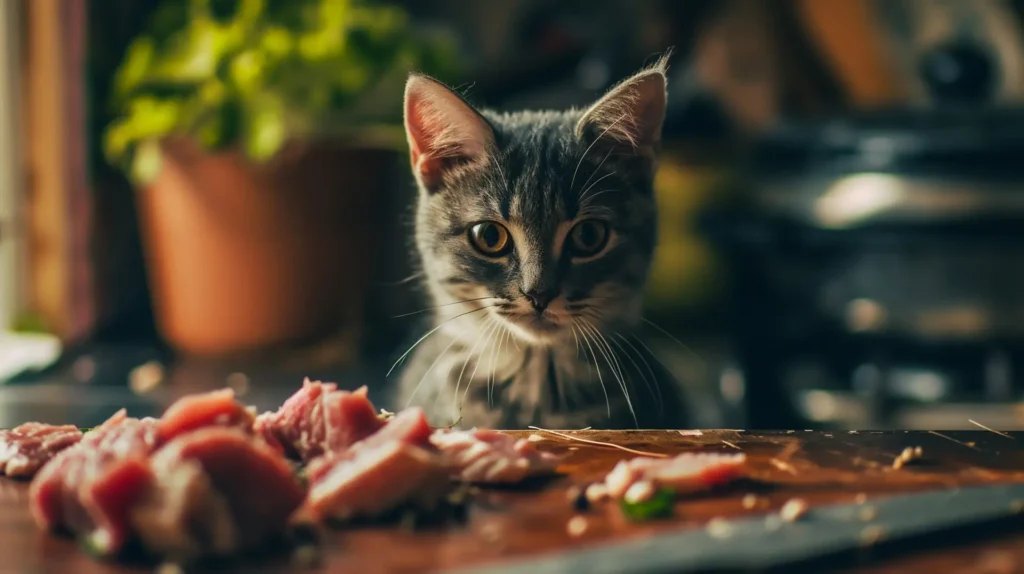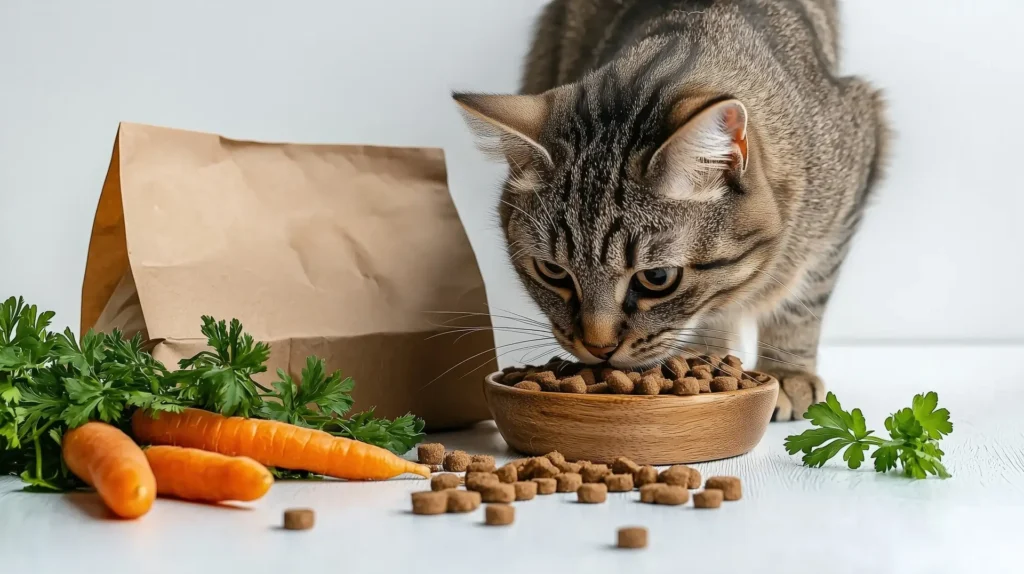Many cat owners choose dry food, or kibble. They like its sheer convenience and cost efficiency. It is simple to store, portion, and leaves no mess. However, picking a high-quality kibble is not easy at all. It requires knowing a cat’s unique biology. A cat is an obligate carnivore. Finding the best dry cat food means finding balance. You must meet a cat’s need for high protein and moisture. This must be balanced with the practicality of kibble. This guide gives you expert criteria. It includes nutritional value analysis and top picks. We cover common pitfalls and future trends, too. We will show you how to choose the best dry cat food for your cats. This ensures they get complete nutrition for a long, healthy life.
Why Dry Cat Food & How It Fits into a Balanced Diet?
Dry cat food is made using a process called extrusion. Ingredients are cooked under high heat and pressure. This results in the low-moisture pellets we call kibble. Understanding its benefits and drawbacks is your first step. This helps you find the best dry cat food possible.
What Dry Cat Food Is and Its Advantages
Kibble offers great practicality for busy cat owners. It truly makes feeding easier.
| Advantage | Explanation |
| Convenience & Shelf Life | Kibble can be left out in a bowl for free feeding. It will not spoil quickly. This makes it ideal for busy schedules. |
| Cost Efficiency | Dry food is generally the most budget-friendly option. It offers affordable options compared to canned food brands. |
| Dental Health | The crunchy texture of kibble helps clean teeth. It provides a mild abrasive action. This can help scrape plaque off the tooth surfaces. |
Disadvantages and Hydration Risk
The main drawback is its very low moisture content. This is typically only 6–10%. Cats naturally get most of their water from their food. A kibble-only diet can lead to chronic, mild dehydration. This low moisture content is strongly linked to urinary health issues. Examples are cystitis and stone formation. This risk is highest in indoor cat formulas. This is because these cats are less active.
How to Balance Dry with Wet and Water Strategies
The best cat food strategy involves proper balance. You can successfully mitigate the hydration risk.
- Free Water Strategies: Use a wide bowl or a running water fountain. This encourages your cat to drink more. (The Russian blue price is often justified by a pet’s needs, not just looks.)
- Mixing: Offer the best wet cat food alongside kibble. This is done to increase daily fluid intake. Offer them mixed or at separate times each day.
When Dry Food Is or Isn’t Ideal
Dry food is not recommended for some cats. This includes cats with a history of recurrent urinary crystals. It also applies to those with chronic kidney disease (CKD). For seniors, especially those with existing dental issues, the best canned cat food is usually better. It is softer and contains more water.
Key Nutritional Criteria for Choosing the Best Dry Cat Food
To select a truly high quality cat food, you must evaluate its nutritional value. A cat’s biology demands a diet built on animal protein and fat sources.
The AAFCO Standard and Label Reading
All commercial dry cat food in the U.S. must meet the standards set by AAFCO. This ensures complete nutrition is delivered. Look for a statement confirming the food is “formulated to meet the nutritional value levels established by the AAFCO Cat Food Nutrient Profiles.”
Essential Macronutrient Ratios
Understanding these ratios is essential knowledge for all cat owners.
| Nutrient | Growth & Reproduction (Kitten) | Adult Maintenance (Adult) | Cat Biology Demand |
| Crude Protein (Min) | 30% | 26% | 40–50% (Wild Diet Equivalent) |
| Crude Fat (Min) | 9% | 9% | 20–30% |
| Carbohydrates (Max) | N/A | N/A | Low (Under 15% is ideal for digestive health) |
Ingredient Quality: Animal vs. Plant Protein
The first few material ingredients on the list matter most. They should be a named meat source. Examples are “Chicken” or “Salmon Meal.” Avoid vague names like “Meat By-Products.” Cats require high protein from animal tissue. This is because they need essential amino acids. These include Taurine and Arginine. These nutrients are not found in plants. Avoiding poor-quality fillers ensures better digestive health.
Avoiding Bad Fillers and Artificial Additives
You should strictly avoid foods with vague fillers. Look for preservative-free formulas instead. Be wary of foods listing artificial colors (like Blue 2 or Red 40). These additives offer zero nutritional value for your cat.
Top Vet-Recommended Best Dry Cat Foods
The best dry cat food brands invest a lot in research. They also conduct crucial feeding trials. This makes them highly recommended by many veterinarians.
| Cat Profile | Focus Criteria | Top Recommended Formula Type |
| Kitten / Growth | High Protein (30%+), DHA for brain health. | Growth stage formulas: high protein density. |
| Senior / Mature | Lower calories, joint support (Glucosamine), and high digestibility. | Senior 7+ formulas; easy-to-chew kibble. |
| Indoor / Low Activity | Moderate calories, indoor cat formula with high fiber for hairballs. | High fiber, L-Carnitine for metabolism. |
| Weight Management | Very high protein (40%+) to support muscle mass. | Weight management formulas: high fiber. |
| Sensitive Digestion | Limited ingredient diets; novel proteins (duck, venison). | Allergy-friendly formulas. |
Top Picks for Specialized Diets
For cats needing specific medical support, the best dry cat food is therapeutic. These choices often come from veterinarian-exclusive lines. Examples are Royal Canin and Hill’s Prescription Diet. For common digestive health needs, look for easily digestible natural ingredients. The torbie cat is no different than any other feline. It needs the same basic nutritional value requirements.
Regional & Market Considerations for Best Dry Cat Food
Most lists focus on the U.S. market only. Global availability, however, varies greatly. When seeking good dry cat food outside North America, look for certain brands. Look for brands that comply with FEDIAF guidelines. FEDIAF is the European Pet Food Industry Federation.
Finding Equivalent Formulas
If your favorite premium brand is unavailable, focus on the Guaranteed Analysis. Aim for 40% protein (dry matter) and low carbohydrates. The availability of affordable options like store brands versus premium brands will differ. This difference is great between the U.S. and markets like the EU or Asia.
Sustainability and Market Trends
The future of the best dry cat food is exciting. It involves novel proteins (like insect protein) and eco-friendly packaging. Always look for transparency in ingredient sourcing.
Cost, Value & Long-Term Budgeting for Best Dry Cat Food
Price does not always equal product quality. The best cat food brands that invest in research generally cost more money. You must learn to compute the true cost.
How to Compute “Cost per Meal”
Always calculate the cost per kg (or cost per pound). A large bag of a slightly more expensive high quality cat food may have a lower “cost per meal.” Investing in better quality food now can mean fewer vet visits later. This makes it a sound long-term decision. This principle is key to maintaining a cat’s health.
Hidden Costs
Hidden costs include spoilage if the food is stored improperly. Food waste is another cost if your cat rejects the flavor completely.
Transitioning & Rotation Strategies
A sudden food switch can cause severe digestive upset. The best dry cat food in the world won’t work if the transition fails.
The 7-Day Transition Protocol
Switching to a new kibble should take at least seven full days:
- Days 1-2: 75% Old Food, 25% New Food
- Days 3-4: 50% Old Food, 50% New Food
- Days 5-6: 25% Old Food, 75% New Food
- Day 7: 100% New Food
Mixing and Rotation
Rotating between 2–3 different reputable cat food brands is an excellent idea. This helps prevent the development of sensitivities. This is why many owners mix kibble with some of the best wet cat food daily.
Troubleshooting Common Dry Food Issues & Myths
Choosing the best cat food means dealing with common problems and misinformation. Knowing the facts is important.
Myths Busted: Grain-Free and Kidneys
- Myth 1: “Grain-free is always better.” The issue is not the grain inclusions. The problem is the carbohydrates. Many grain-free foods replace grains with high-carb starches. Examples are potatoes or peas. These are not ideal for digestive health. Focus on high protein. Do not focus on the absence of grain-based formulas.
- Myth 2: “Dry food is always bad for the kidneys.” Dry food does not cause kidney failure. But its low moisture content can make existing conditions worse. For cats with CKD, a prescription renal diet (often wet) is necessary.
Cat Refusal Fixes
If your calico cat refuses new kibble, try warming it slightly. A small amount of fat releases aroma. You could also mix it with a small amount of low-sodium broth.
Sustainability, New Trends & Novel Proteins
The market for high quality cat food is constantly evolving right now.
Future of Kibble
New trends focus on reducing the environmental impact of premium brands. This includes insect protein. This offers high protein with low environmental cost. Other trends include lab-grown meat and using certified natural ingredients.
Personalized Nutrition
Smart feeders and veterinary diagnostics are leading the way. They lead to personalized nutrition for your pet. Specialty formulas are tailored to a cat’s specific genetic needs.
Real Owner Stories & Case Studies
Many owners report significant health improvements. This happens after switching from low-end formulas to a premium brand. A common story involves a dark calico cat. It had persistent vomiting that stopped entirely. This happened after switching to an allergy-friendly, limited-ingredient food. Monitoring stool quality, coat shine, and energy levels is the best way. This is how you pick cat food that truly works for them.
How to Choose the Best Dry Cat Food for Your Cat?
Finding the best dry cat food requires matching the food to the individual needs of your cats.
Quick Decision Checklist
Use this simple checklist before you buy the food:
- Life Stage Match: Is it a kitten, adult, or senior formula?
- Protein Check: Is the protein high protein (at least 35% DM)? Are the first two ingredients named meats?
- Moisture Strategy: Are you committed to adding a best rated wet cat food or extra water daily?
- Health Needs: Does your cat need a weight management or urinary health formula?
Red Flags to Avoid
Avoid certain foods when you are shopping. Avoid foods that rely on vague, non-specific protein sources (“meat by-products”). Also, avoid a very long list of unpronounceable chemical preservatives. The best dry cat food uses simple, natural ingredients.
When to Consult a Vet
Always consult your veterinarian for advice. Do this before switching to a medical-grade or specialty formula. They can give the best advice.
Conclusion
Choosing the best dry cat food means looking past marketing hype. You must focus on three main factors. These are high quality animal protein, low carbohydrates, and a proactive hydration strategy. Whether you choose a grain-free option or grain-based formula, the nutritional value must meet high standards. These are the standards of an obligate carnivore. Revisit your choices annually. A cat’s needs change with both age and activity. Find the best dry cat food for indoor cats and start monitoring their health today.
FAQs
What is the healthiest cat food on the market?
The healthiest wet cat food brands and dry foods prioritize animal-based, high, and low-carbohydrate foods. This is true regardless of grain-free options or grain inclusions. Look for the AAFCO statement and formulas backed by scientific feeding trials.
Is Friskies canned cat food healthy?
Friskies meets AAFCO minimum standards for complete nutrition. It is generally considered a budget-tier brand. It may contain more grain inclusions or by-products compared to premium brands. The best canned cat food tends to have a higher ratio of named muscle meat.
What are the top 5 healthiest cat foods?
Top-rated brands include those recommended by veterinary nutritionists. They focus on research and quality control. Examples often include Purina Pro Plan, Hill’s Science Diet, Royal Canin, and select premium brands.
When can kittens eat dry food?
Kittens can typically begin eating small amounts of specially formulated kitten best dry cat food around 4–5 weeks of age. By 8–10 weeks, they should be fully weaned. They should be consuming kitten kibble that offers dense, complete nutrition and high levels of DHA for growth.




